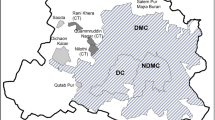Population growth is an important factor for local environment change. More importantly, the consumption level and the technology assume to play a vital role in the overall environmental change. Ehrlich and Ehrlich (1990) argue that population growth causes a disproportionate negative impact on the environment. Commoner et al (1971) in their study conclude that though population plays role in environmental deterioration, it is by no means only a major factor of environmental crisis.The technology factor plays a much more significant role in the ecological crisis.
Rapid population growth is one of the main reasons for increasing the number of people on the move for livelihood, and migration has been a major factor of rapid population growth in urban areas in less developed countries (LDCs). Lee (1969), Todaro (1976), and Goldscheider (1983) emphasize the pull of the urban sector for urban bound migration. However for the urban pull to be operative, the population in the hinterland must be conducive to dislocation. While others argue that the stimulus for migration in LDCs lies in the rural condition. In other words, the accretion of unemployed migrants in urban areas in LDCs is indicative less of urban dynamism than of strong repulsive forces operating in rural areas (Gurung 1989). Zelinsky et al (1970) and Ng (1975) argue that out-migration from rural areas is primarily due to the growth of the local population beyond the carrying capacity of the land. Excessive pressure on land resource and increasing poverty generate a large volume of migration (Kosinski and Prothero 1975; Zelinsky 1983). All poor people do not often move out despite intensive resource pressure. Goldscheider (1983) concludes that the poorer the people, the stronger the impediments to moving. This observation may be true for rural-urban movement in Nepal (Gurung 1989).
This paper analyses population growth and migration, urbanisation and their impacts on environmental condition of the urban areas of Kathmandu Valley, Nepal. Based on the available information, the magnitude of environmental impacts has been examined. In the end, policy measures so far undertaken on the part of the government of Nepal have also been presented.
Access this chapter
Tax calculation will be finalised at checkout
Purchases are for personal use only
Preview
Unable to display preview. Download preview PDF.
Similar content being viewed by others
Author information
Authors and Affiliations
Editor information
Editors and Affiliations
Rights and permissions
Copyright information
© 2004 Kluwer Academic Publishers
About this chapter
Cite this chapter
Pradhan, P.K. (2004). Population Growth, Migration and Urbanisation. Environmental Consequences in Kathmandu Valley, Nepal. In: Unruh, J.D., Krol, M.S., Kliot, N. (eds) Environmental Change and its Implications for Population Migration. Advances in Global Change Research, vol 20. Springer, Dordrecht. https://doi.org/10.1007/978-1-4020-2877-9_9
Download citation
DOI: https://doi.org/10.1007/978-1-4020-2877-9_9
Publisher Name: Springer, Dordrecht
Print ISBN: 978-1-4020-2868-7
Online ISBN: 978-1-4020-2877-9
eBook Packages: Springer Book Archive




